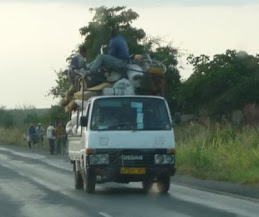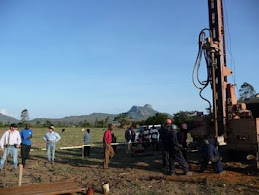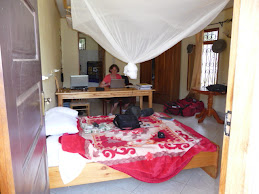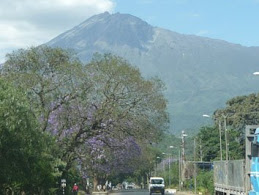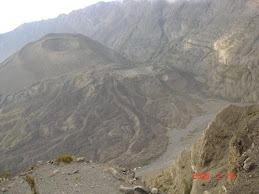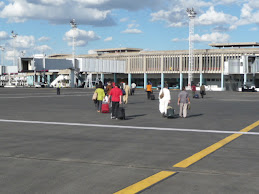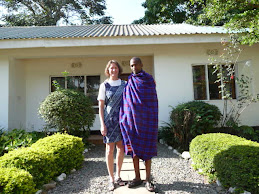Sunday, December 13, 2009
The Passing of Boots
This last week we got a call from our house sitters in Melbourne that our dear little cat Boots had had a stroke and couldn’t walk. The vet said there was nothing they could do for him and so we had to let him go. He was 13. We are feeling so sad. Ever since we have been married we have virtually had our cats Kimba and Boots. He was such a great little friend. He would follow us around the house or yard just to be with us and talk with us. He had a great sense of humour and loved to play. Every day when we used to come home from work in Melbourne the cats would meet us with great affection. They could brighten any day. Boots would sprawl out on the bed every night forcing us into uncomfortable contorted positions to make room for him, but we never complained, it was so nice to have him there like that. We were truly blessed to share his life and he will be missed greatly. He was our little boy.
Saturday, December 12, 2009
Lake Eyasi – A Cultural Visit
This last weekend we went on another camping trip with almost the same people we went to Lake Natron with. Alan and Andrea are due to leave Tanzania after 3 years here, so it was our last adventure with them. They go back to Aust & New Zealand. We had become good friends with them so it is sad to see them go. On this trip we did not take our little Pajero and instead rode in the Landrover of Alan and Andrea. They had said the road would be rougher than the Lake Natron road which was quite bad in places. No tarseal of course. This Lake is out west in the same direction as Natron sort of, but further west. We left Friday night after work and drove to a town called Karatu about 2 hours out of Arusha. That is the end of the sealed road. We spent the night in quite a modern camp ground. We walked to the Happy Days restaurant next door and had burgers and cold drinks out on a wooden deck. Back at the camp ground we went into the lodge bar where they were playing Country and Western music. We gave Andrea some Two-Stepping lessons.
The next morning it was west off the tarseal towards Lake Eyasi. Another 2 hr drive along well defined but crude dirt track. At often times the local kids would see the trucks coming and run to the edge of the track and call out for candy or pens (of all things). The camp round was a nice long grassy grove amongst some Acacia and other tall trees with black seed pods about the size of a tennis ball. It was on the side of the lake bed but like Natron, the lake was well down and it was about 2 km out to the water’s edge over a lifeless and very hot mud flat. It is an alkaline lake so there is very little life around there. No fish in the lake at all, hence no feeding birds either naturally. We never actually saw the water. Back at the tent sites, Alan pointed out the seed pods made good Platunc balls. We spent several hours playing a game of that. During which Bruce discovered he had a puncture in his van tyre. Bruce wanted to fix the puncture there as there are little facilities in the local Eyasi village. It took a while to get the tyre off the rim and it was hot. Warm cokes (no cold drinks available) were going down a plenty. The camp ground has a reasonable shower and toilets (holes in the ground surrounded by a bunch of sticks tied together). So a shower afterwards was welcome. Just before dusk we went up to a cliff top that gave impressive over views of the sunset over the lake and surrounding area. The sunset was a classic picturesque African rich deep orange sunset. Magnificent. We even were fortunate to see a striped Hyena slinking through the bush below. Alan had seen it on his last trip to Eyasi a year ago too he said.
The reason we went to Eyasi is that there are some isolated tribal people who live there in their old tribal ways. They are ‘off the grid’ so to say and pretty much keep to their old ways and not intermingle with the regular people. This is a very dry arid area making quite a primitive lifestyle. Too tough for us. Two tribes we wanted to see were the Hadzabe and Datoga. So on Sunday morning the local guide we had hired the day before showed up with three Hadzabe men. They were to show us where to find a Hadzabe village. The Hadzabe are hunters, not farmers. So they are always on the move after animals to hunt. They have no electricity in their villages, no water supply, no schools, no permanent houses, only basic structures made from sticks that looks like a stick igloo. If they kill a big animal like a Water Buffalo and the carcass is too heavy to bring back to the village, they just move the village to the carcass.
These three Hadzabe wanted us to take them to a special big rock where a particular plant grew. The plant they used to extract a poison from to put on the tips of their arrows. They would boil down some of the branches of this plant to make this poison for their arrows. Apparently this poison could drop a buffalo in about 30 mins. Powerful stuff. They normally took three days to walk to this rock so being driven in a landrover was a treat for them. One of them had a stiff leg whose knee no longer worked. A few years ago he had gotten into a tussle with a water buffalo they had shot with a poisoned arrow and thought was dead. However when they approached it, it turned out to be a different buffalo and was angry about being woken up so took to this guy galling his leg badly. The three Hadzabe with us were not used to vehicles so wanted to ride on the roof rack on top instead of getting inside the vehicle. Made for a good picture. We drove to this rock along the eastern side of the lake not along any road we could see. However when we got there a few Tanzanian locals came out at the sight of 6 mzungus and wanted to charge us a visiting fee. Even though we were just there to allow the Hadzabe to collect their plant clippings, they still said the mungus had to pay first. So we left, we are not into paying bribes. We drive a few more miles to the village cultural center where we could pay an official entrance fee for their area. These fees then should go to the village development rather than to someone’s pocket. But the office was unmanned and no one could find anyone to come and open it. So we left there too.
On to a Hadzabe village. It was a small village of only about 20 people, 4-5 families. ½ dozen young kids and some teenagers with parents. Dressed in loose skins. They let us shoot their bows for a while. They could hit a 6” target at about 25 m no problem at all. After 3 goes I actually hit the target. However I could only pull the bows back about ½ what they did and they were all shorter than me. So my arrow would have had no penetrating power. Some of the people with us bought a bow and a set of arrows as souvenirs.
After that we went to a Datoga village. These people are quite different. More sophisticated than the Hadzabe. They wear nicely tailored clothes from skins. Their houses are permanent mud brick houses. They perform a small amount of industry with the smeltering of metals to make arrow heads, that they sell to the Hadzabe, or make bracelets or other jewellery that the women then sell to tourists like us we presume. They had a crude set of bellows made to make their fires hot enough to melt brass (old padlocks) and bronze or soften steel. They managed to sell a few arrow heads and bracelets to our group. They grew some crops and showed Ramona and Andrea how to grind the maize into a powder. Very nice and friendly people.
The next day as we were packing up to return to Arusha, a couple who had been in the camp ground too, came and asked us for a ride back to town if we had room. They were on their honeymoon travelling around Northern Tanzania. He was Scottish and she was German. An interesting couple. Patrick worked for the Red Cross and had just finished 5 years in Afghanistan. He had some good tales to tell. We met up with them two nights later to go to dinner in Arusha to hear more of their work and travels. Their next assignment was in Chad. A different career path to most people.
The next morning it was west off the tarseal towards Lake Eyasi. Another 2 hr drive along well defined but crude dirt track. At often times the local kids would see the trucks coming and run to the edge of the track and call out for candy or pens (of all things). The camp round was a nice long grassy grove amongst some Acacia and other tall trees with black seed pods about the size of a tennis ball. It was on the side of the lake bed but like Natron, the lake was well down and it was about 2 km out to the water’s edge over a lifeless and very hot mud flat. It is an alkaline lake so there is very little life around there. No fish in the lake at all, hence no feeding birds either naturally. We never actually saw the water. Back at the tent sites, Alan pointed out the seed pods made good Platunc balls. We spent several hours playing a game of that. During which Bruce discovered he had a puncture in his van tyre. Bruce wanted to fix the puncture there as there are little facilities in the local Eyasi village. It took a while to get the tyre off the rim and it was hot. Warm cokes (no cold drinks available) were going down a plenty. The camp ground has a reasonable shower and toilets (holes in the ground surrounded by a bunch of sticks tied together). So a shower afterwards was welcome. Just before dusk we went up to a cliff top that gave impressive over views of the sunset over the lake and surrounding area. The sunset was a classic picturesque African rich deep orange sunset. Magnificent. We even were fortunate to see a striped Hyena slinking through the bush below. Alan had seen it on his last trip to Eyasi a year ago too he said.
The reason we went to Eyasi is that there are some isolated tribal people who live there in their old tribal ways. They are ‘off the grid’ so to say and pretty much keep to their old ways and not intermingle with the regular people. This is a very dry arid area making quite a primitive lifestyle. Too tough for us. Two tribes we wanted to see were the Hadzabe and Datoga. So on Sunday morning the local guide we had hired the day before showed up with three Hadzabe men. They were to show us where to find a Hadzabe village. The Hadzabe are hunters, not farmers. So they are always on the move after animals to hunt. They have no electricity in their villages, no water supply, no schools, no permanent houses, only basic structures made from sticks that looks like a stick igloo. If they kill a big animal like a Water Buffalo and the carcass is too heavy to bring back to the village, they just move the village to the carcass.
These three Hadzabe wanted us to take them to a special big rock where a particular plant grew. The plant they used to extract a poison from to put on the tips of their arrows. They would boil down some of the branches of this plant to make this poison for their arrows. Apparently this poison could drop a buffalo in about 30 mins. Powerful stuff. They normally took three days to walk to this rock so being driven in a landrover was a treat for them. One of them had a stiff leg whose knee no longer worked. A few years ago he had gotten into a tussle with a water buffalo they had shot with a poisoned arrow and thought was dead. However when they approached it, it turned out to be a different buffalo and was angry about being woken up so took to this guy galling his leg badly. The three Hadzabe with us were not used to vehicles so wanted to ride on the roof rack on top instead of getting inside the vehicle. Made for a good picture. We drove to this rock along the eastern side of the lake not along any road we could see. However when we got there a few Tanzanian locals came out at the sight of 6 mzungus and wanted to charge us a visiting fee. Even though we were just there to allow the Hadzabe to collect their plant clippings, they still said the mungus had to pay first. So we left, we are not into paying bribes. We drive a few more miles to the village cultural center where we could pay an official entrance fee for their area. These fees then should go to the village development rather than to someone’s pocket. But the office was unmanned and no one could find anyone to come and open it. So we left there too.
On to a Hadzabe village. It was a small village of only about 20 people, 4-5 families. ½ dozen young kids and some teenagers with parents. Dressed in loose skins. They let us shoot their bows for a while. They could hit a 6” target at about 25 m no problem at all. After 3 goes I actually hit the target. However I could only pull the bows back about ½ what they did and they were all shorter than me. So my arrow would have had no penetrating power. Some of the people with us bought a bow and a set of arrows as souvenirs.
After that we went to a Datoga village. These people are quite different. More sophisticated than the Hadzabe. They wear nicely tailored clothes from skins. Their houses are permanent mud brick houses. They perform a small amount of industry with the smeltering of metals to make arrow heads, that they sell to the Hadzabe, or make bracelets or other jewellery that the women then sell to tourists like us we presume. They had a crude set of bellows made to make their fires hot enough to melt brass (old padlocks) and bronze or soften steel. They managed to sell a few arrow heads and bracelets to our group. They grew some crops and showed Ramona and Andrea how to grind the maize into a powder. Very nice and friendly people.
The next day as we were packing up to return to Arusha, a couple who had been in the camp ground too, came and asked us for a ride back to town if we had room. They were on their honeymoon travelling around Northern Tanzania. He was Scottish and she was German. An interesting couple. Patrick worked for the Red Cross and had just finished 5 years in Afghanistan. He had some good tales to tell. We met up with them two nights later to go to dinner in Arusha to hear more of their work and travels. Their next assignment was in Chad. A different career path to most people.
Subscribe to:
Comments (Atom)
































































































































